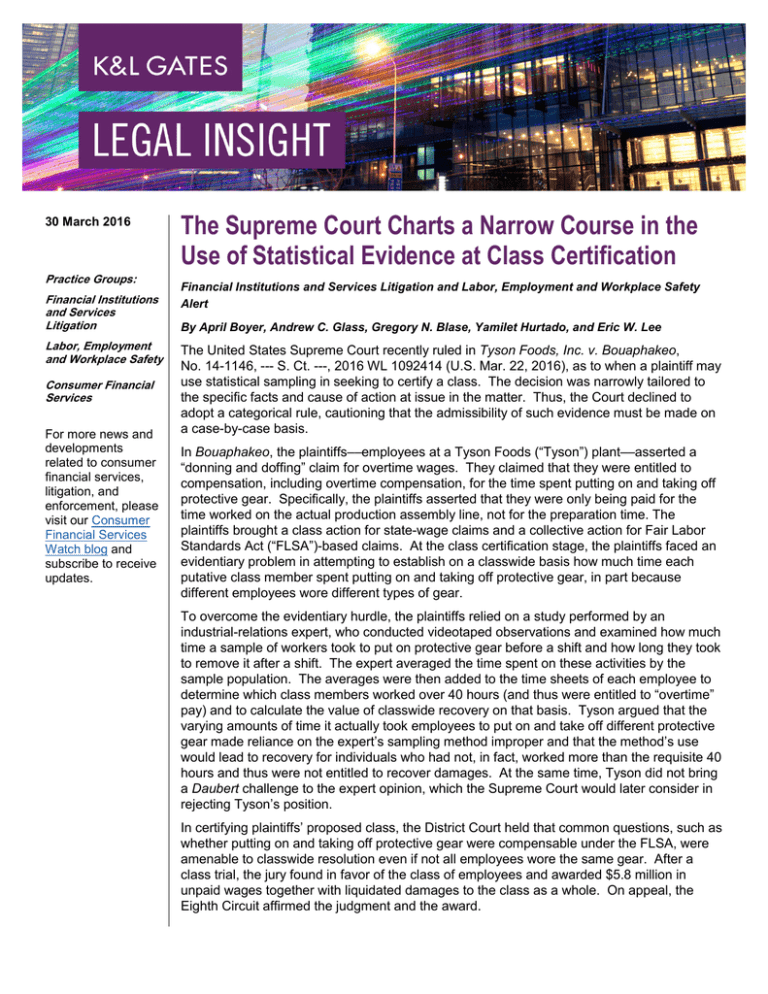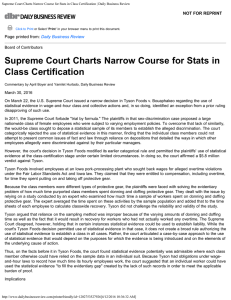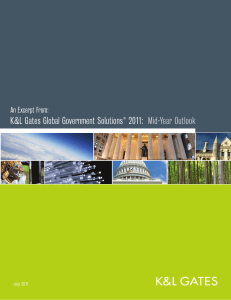
30 March 2016
Practice Groups:
Financial Institutions
and Services
Litigation
Labor, Employment
and Workplace Safety
Consumer Financial
Services
For more news and
developments
related to consumer
financial services,
litigation, and
enforcement, please
visit our Consumer
Financial Services
Watch blog and
subscribe to receive
updates.
The Supreme Court Charts a Narrow Course in the
Use of Statistical Evidence at Class Certification
Financial Institutions and Services Litigation and Labor, Employment and Workplace Safety
Alert
By April Boyer, Andrew C. Glass, Gregory N. Blase, Yamilet Hurtado, and Eric W. Lee
The United States Supreme Court recently ruled in Tyson Foods, Inc. v. Bouaphakeo,
No. 14-1146, --- S. Ct. ---, 2016 WL 1092414 (U.S. Mar. 22, 2016), as to when a plaintiff may
use statistical sampling in seeking to certify a class. The decision was narrowly tailored to
the specific facts and cause of action at issue in the matter. Thus, the Court declined to
adopt a categorical rule, cautioning that the admissibility of such evidence must be made on
a case-by-case basis.
In Bouaphakeo, the plaintiffs––employees at a Tyson Foods (“Tyson”) plant––asserted a
“donning and doffing” claim for overtime wages. They claimed that they were entitled to
compensation, including overtime compensation, for the time spent putting on and taking off
protective gear. Specifically, the plaintiffs asserted that they were only being paid for the
time worked on the actual production assembly line, not for the preparation time. The
plaintiffs brought a class action for state-wage claims and a collective action for Fair Labor
Standards Act (“FLSA”)-based claims. At the class certification stage, the plaintiffs faced an
evidentiary problem in attempting to establish on a classwide basis how much time each
putative class member spent putting on and taking off protective gear, in part because
different employees wore different types of gear.
To overcome the evidentiary hurdle, the plaintiffs relied on a study performed by an
industrial-relations expert, who conducted videotaped observations and examined how much
time a sample of workers took to put on protective gear before a shift and how long they took
to remove it after a shift. The expert averaged the time spent on these activities by the
sample population. The averages were then added to the time sheets of each employee to
determine which class members worked over 40 hours (and thus were entitled to “overtime”
pay) and to calculate the value of classwide recovery on that basis. Tyson argued that the
varying amounts of time it actually took employees to put on and take off different protective
gear made reliance on the expert’s sampling method improper and that the method’s use
would lead to recovery for individuals who had not, in fact, worked more than the requisite 40
hours and thus were not entitled to recover damages. At the same time, Tyson did not bring
a Daubert challenge to the expert opinion, which the Supreme Court would later consider in
rejecting Tyson’s position.
In certifying plaintiffs’ proposed class, the District Court held that common questions, such as
whether putting on and taking off protective gear were compensable under the FLSA, were
amenable to classwide resolution even if not all employees wore the same gear. After a
class trial, the jury found in favor of the class of employees and awarded $5.8 million in
unpaid wages together with liquidated damages to the class as a whole. On appeal, the
Eighth Circuit affirmed the judgment and the award.
The Supreme Court Charts a Narrow Course in the Use of Statistical Evidence
at Class Certification
The Supreme Court’s Decision
The Supreme Court affirmed in a 6–2 decision, with Justice Kennedy delivering the opinion
of the Court. The Court stated, “[w]hether and when statistical evidence can be used to
establish classwide liability will depend on the purpose for which the evidence is being
introduced and on the elements of the underlying cause of action.” 1 The Court held that
statistical or representative evidence is permissible where “each class member could have
relied on that sample to establish liability if he or she had brought an individual action.” 2 The
Court emphasized that representative evidence was appropriate in this case “to fill the
evidentiary gap” created by Tyson’s failure to keep adequate time records as required under
the FLSA. The Court ruled that in a circumstance where required records are absent, an
employee may produce “evidence to show the amount and extent of work as a matter of just
and reasonable inference.” 3
In deciding the matter, the Court distinguished Wal-Mart Stores, Inc. v. Dukes. 4 There, the
Court had rejected the use of representative evidence in a nationwide employment
discrimination class action. In particular, the Dukes plaintiffs sought to rely on deposition
testimony of a statistical sample of the class in an attempt to overcome the fact that the
putative class members were not subject to a common policy of employment discrimination.
The Court, however, rejected this proposed “trial by formula,” determining that because the
individual class members were not similarly situated, none of them could have prevailed in
an individual suit by relying on depositions detailing the ways in which other employees were
discriminated against by their particular managers. In contrast, the Bouaphakeo court stated
that the employees worked at a single facility, did similar work, were paid under the same
policy, and could have introduced the expert’s study in a series of individual lawsuits.
The Court did not accept Tyson’s argument that reliance on statistical evidence would strip it
of the ability to defend the suit. In doing so, the Court pointed out that a defendant has the
ability to challenge the statistical study under Daubert or otherwise establish that the study
was not representative, but that Tyson had not pursued those avenues.
The Court did not reach the second issue presented in the case, namely whether class
members who did not work more than 40 hours per week and were thus ineligible for
overtime pay could recover based upon the statistical evidence, despite lack of actual harm.
Instead, the Court ruled that the issue was not ripe because the $5.8 million award had not
yet been distributed to class members.
The Chief Justice separately concurred (joined in part by Justice Alito) to emphasize that the
Court’s ruling does not recognize a relaxed standard of proof under the FLSA. 5 In addition,
the Chief Justice expressed that the jury verdict could not stand if the statistical evidence did
not establish a right to recover damages on behalf of each class member. 6 In particular, the
Chief Justice stated, “[i]f there is no way to ensure that the jury’s damages award goes only
1
2
3
4
5
6
Bouaphakeo, 2016 WL 1092414, *8 (internal quotation omitted).
Id.
Id. (quoting Anderson v. Mt. Clemens Pottery Co., 328 U.S. 680, 687 (1946)).
564 U.S. 338 (2011).
Bouaphakeo, 2016 WL 1092414 at *13 (Roberts, C.J., concurring).
Id. at *14–15 (Roberts, C.J., concurring).
2
The Supreme Court Charts a Narrow Course in the Use of Statistical Evidence
at Class Certification
to injured class members, that award cannot stand. This issue should be considered by the
district court in the first instance.” 7
In a dissent joined by Justice Alito, Justice Thomas went further, opining that the District
Court erred in certifying a class where the statistical evidence was insufficient to establish
common proof of liability (i.e., uncompensated overtime worked) as to each class member.8
Implications of the Decision
Because the circumstances under which the use of statistical evidence will vary from case to
case, the Court declined to adopt a categorical rule governing the use of such evidence in
class actions. Rather, Bouaphakeo mandates that in assessing whether a class may be
certified, a trial court must review the admissibility of statistical or representative evidence
based on the specific circumstances of the case at hand, the purpose for which the plaintiff
seeks to introduce the evidence, and the nature of the underlying cause of action.
Important to the Bouaphakeo decision is the unique scenario the FLSA creates. Employers
are specifically obligated under the FLSA to maintain time records. In Bouaphakeo,
however, the employer did not have time records of how long the workers spent donning and
doffing protective gear. The Court thus relied on the absence of the requisite time records in
finding permissible the plaintiffs’ use of statistical evidence to support their claims. While the
Bouaphakeo decision permits the use of statistical evidence to establish classwide liability in
that narrow circumstance, such evidence may not be appropriate in many other legal and
factual settings. Nonetheless, business entities should carefully examine the Court’s
guidance in Bouaphakeo, including the following admonitions:
• To maintain adequate records (especially time records for FLSA compliance) to avoid
creating “evidentiary gaps” that might entitle a plaintiff to use representative evidence;
• To scrutinize and challenge the methodologies deployed when statistical evidence is
proffered, including bringing appropriate Daubert challenges; and
• To consider options such as bifurcating the liability and damages stages of litigation to
mitigate potential problems with the inclusion of uninjured class members.
Authors:
April Boyer
april.boyer@klgates.com
+1.305.539.3380
Andrew C. Glass
andrew.glass@klgates.com
+1.617.261.3107
Gregory N. Blase
gregory.blase@klgates.com
+1.617.951.9059
7
8
Id. (Roberts, C.J., concurring).
Id. at *16–17 (Thomas, J., dissenting).
3
The Supreme Court Charts a Narrow Course in the Use of Statistical Evidence
at Class Certification
Yamilet Hurtado
yamilet.hurtado@klgates.com
+1.305.539.3340
Eric W. Lee
eric.lee@klgates.com
+1.617.951.9240
Anchorage Austin Beijing Berlin Boston Brisbane Brussels Charleston Charlotte Chicago Dallas Doha Dubai Fort Worth Frankfurt
Harrisburg Hong Kong Houston London Los Angeles Melbourne Miami Milan Newark New York Orange County Palo Alto Paris Perth
Pittsburgh Portland Raleigh Research Triangle Park San Francisco São Paulo Seattle Seoul Shanghai Singapore Spokane
Sydney Taipei Tokyo Warsaw Washington, D.C. Wilmington
K&L Gates comprises more than 2,000 lawyers globally who practice in fully integrated offices located on five
continents. The firm represents leading multinational corporations, growth and middle-market companies, capital
markets participants and entrepreneurs in every major industry group as well as public sector entities, educational
institutions, philanthropic organizations and individuals. For more information about K&L Gates or its locations,
practices and registrations, visit www.klgates.com.
This publication is for informational purposes and does not contain or convey legal advice. The information herein should not be used or relied upon in
regard to any particular facts or circumstances without first consulting a lawyer.
© 2016 K&L Gates LLP. All Rights Reserved.
4


